In Land Research, Arkadi Zaides presents a stark landscape: images projected on a large screen at the back of a wide stage empty of all props, except a mic stand at the front left. Land Research was performed in Israel on July 30, 2012 as part of the Summerdance Festival at Suzanne Dellal in Tel Aviv, continuing his process of developing an artistic dialogue with artists from a variety of disciplines and backgrounds, into this landscape enter performers: dancer Yuli Kovbasnyan who immigrated alone to Israel from Russia in her teens, Ofir Yudilevitch, a dancer with an extensive background in acrobatics and Capoeira, Palestinian artist and actress Raida Adon, performer and video artist Sva Li-Levy, and dancer/acrobatics practitioner Asaf Aharonson.
In a movement language that is abstract, intensely physical and articulated in gestural detail, each gives voice to his or her personal relationship to the land and landscape – internal, external, conceptual, symbolic, physical, historical, textual, and emotional. Each presence is distinct, and deeply felt. The stage, free of objects, creates a space in which one can let things happen, and time itself seems to open up.
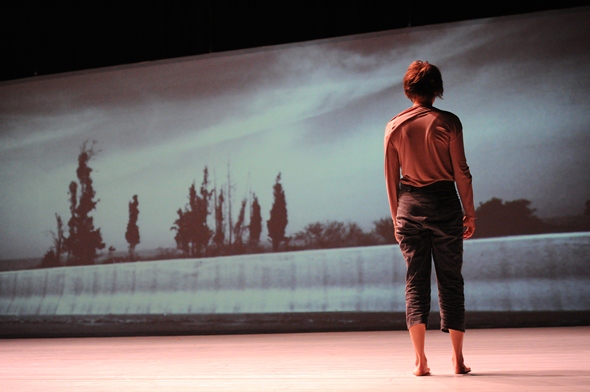
The work begins in silence, as the images on the screen give way to the work’s title – in English, Arabic and Hebrew, like the opening credits of a film. A woman, Yuli Kovbasnyan, walks onto the stage, and the quality of her movements, at first small and delicately nuanced, create tension and attention. Her eyes look out, wide and wondering, questioning, perhaps fearful. At one point her hands are held out in front of her body, palm up, fingers loosely open; at another juncture she is contorted on the floor, her arm bent behind her back.
There is a twisting asymmetry to Zaides’ movement language that intrigues me, a contrasting vocabulary of intensity and an open quality, tightly spiraling inward, moving light and loose across the stage, myriad articulations of the body and its infinite, surprising combinations – all charged with intention.
As they reveal themselves in movement, sound and image – I am curious to know more about these people, and the stories they tell. Ofir Yudilevitch shares the intimacy of his breath, creating a changing sound-scape as he moves through the space, and returns to the mic to make a record of this effort, sliding along the land, tearing through the air; moved by internal impulse, pulled by external forces, this heroic exhaustive effort of moving. Yuli, Ofir – each one in turn performs a solo, and then walks to the edges of the stage, sits and remains there for the duration of the work, in a position of observation or contemplation.
Raida Adon walks on and stands silent, immobile, facing the audience, dressed in black. Her presence is formidable, solemn. When she begins to move her arms, the movement has an almost ritual feel. Making large circles in the air, gathering momentum, she takes a journey through time, her feet moving in folk rhythms, she chants in Arabic, evoking the playful rhythms of childhood; then turns to more turbulent, tormented moments, before returning to the present moment: still, silent.
Sva Li-Levy enters talking – a riveting riff on the body, comic and captivating as he contorts into a pretzel of perpetual motion. The endless flow of clever associations relating the body and the subjective perception of one’s body – “I talk to my body…we have very good contact…I am very physical” – to contemporary culture – the technological ability to “look inside my body…see all the geological layers” – history and wild imaginings, integrated with the movement like the pieces of a puzzle, this brilliant performance introduced a delightful element to the work (and happily introduced me to a performer I had not yet encountered), the sense of surprise that there are yet so many different ways to approach a theme, so much yet to be discovered, experienced and savored.
Venturing deeper into this land, becoming acquainted with its people and their stories, I watched and listened with a sense of anticipation. A secret expectation filled me with mounting tension as I waited for the moment that would surely arrive. Five performers, each with a different body, story, voice and movement; each presented his or her personal perspective. When the fifth performer came onto the stage, I knew that one way or another, something must be resolved.
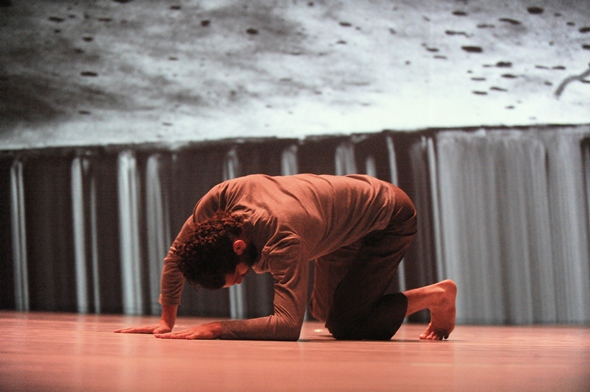
Asaf Aharonson walked on and almost immediately took to the ground, initiating a circular movement then rising, and covering his mouth with his arm. He spoke, yet I could not understand his words because his mouth remained covered. I watched him move – wandering through the space, arms flailing, head hidden in his arm, reaching the floor again to kneel forward in a prayer-like position – and still, I waited.
In Land Research, each performer is given the time and space to be seen and heard, yet each remains isolated within his or her own story. I waited for the moment when they would meet, the people who live their lives on this land. I waited for the moment will they would talk to one another; I waited for the moment when they would touch one another; I waited for the moment when the individual voices become a dialogue. And I am still waiting.
Land Research will be performed at the Suzanne Dellal Centre on April 11, 2013. Tickets may be purchased online at the Suzanne Dellal website.
concept, choreography and direction: Arkadi Zaides; research, guidance and artistic collaboration: Anat Cederbaum; performers: Raida Adon, Asaf Aharonson, Sva Li Levy, Yuli Kovbasnyan, Ofir Yudilevitch; photographer: Yuval Tebol; video design: Daniel Landau; music: Tom Tlalim & Chen Wagner; dramaturgy: Joanna Lesnierowska; light: Bruno Pocheron; artistic advise: Felix Ritter; costumes: Nadav Svetlov; producer: Hila Kaplan



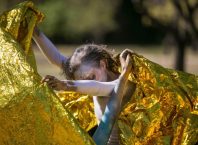
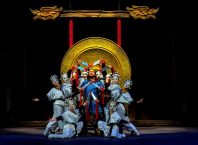
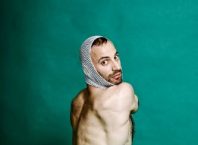
Comments are closed.